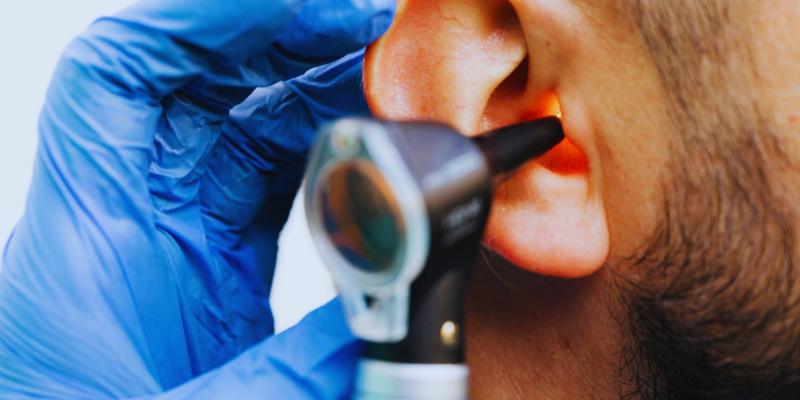Diagnosing and Treating a Cholesteatoma: Everything You Need to Know
If not addressed, a cholesteatoma, an aberrant skin growth in the middle ear, can cause major problems. It results from skin cells accumulating behind the eardrum, causing hearing loss and bone deterioration. Those with persistent ear infections are more prone to this disorder. Common complaints are ear pain, hearing loss, and ongoing ear leakage. An ear exam allows a doctor to identify cholesteatoma.
Treatment usually consists of surgery to eradicate the development. If untreated, cholesteatoma could cause infections, irreversible ear damage, or vertigo. This article discusses the causes, symptoms, and medicinal therapies for cholesteatoma. Awareness of this disease is crucial for seeking appropriate medical treatment. Early diagnosis and treatment help preserve the general ear and hearing, preventing major long-term consequences.

Causes and Risk Factors
Birth abnormalities or acquired diseases are among the several causes of a cholesteatoma.
- Eustachian tube dysfunction pulls the eardrum inward, producing negative pressure in the middle ear. It causes skin accumulation and raises the risk of cholesteatoma formation.
- Ear injuries: Trauma to fragile ear structures can include a perforated eardrum or a forceful impact. This damage might interfere with normal healing and provide conditions favorable for aberrant skin development.
- Previous ear surgeries: Certain surgeries change the ear's architecture, influencing ventilation and drainage. These modifications might cause skin buildup, which raises a gradually growing risk of cholesteatoma.
- Sinus infections: Chronic sinus irritation can block the eustachian tube, impeding appropriate ear discharge. It produces a moist environment that promotes skin accumulation and infection.
- Poor ear hygiene: Too much wax accumulation or object insertion, like cotton swabs, may force trash farther into the ear. This irritability raises the risk of cholesteatoma formation and can cause infections.
Symptoms of a Cholesteatoma
A cholesteatoma causes slow development of symptoms that initially seem minor but get worse with time. The most common symptom is a bad-smelling ear discharge from dead skin and bacterial accumulation. A cholesteatoma may be indicated by ongoing discharge that does not get better with treatment. Another main complaint is hearing loss since increasing obesity weakens the little bones in the middle ear, impairing clear hearing.
Some people get ear ringing, vertigo, or ear pressure tinnitus. Though pain is not usually present, some people experience ear discomfort, fullness, or a blocked sensation. Severe forms of cholesteatoma can compromise the facial nerve, causing muscle paralysis on one side of the face. See a doctor right away if you run across any of these symptoms. Early diagnosis and treatment help to avoid major problems, including more damage to the ear structures and permanent hearing loss.
How Doctors Diagnose a Cholesteatoma
Examining the ear closely helps doctors identify a cholesteatoma. They employ an otoscope to search the ear canal for evidence of aberrant growth. Other investigations could be required if they find bulk or recurring ear discharge. Audiometry, a hearing test, can determine whether the cholesteatoma compromises hearing. This test gauges a patient's response to and perception of certain sound frequencies. If one finds hearing loss, more investigation could be required.
A CT scan gives clinicians a comprehensive image of the ear structures, guiding their assessment of the size of the cholesteatoma. This imaging test indicates whether the expansion has progressed to deeper regions, which might call for surgical elimination. Prevention of major consequences depends on early diagnosis. See a doctor immediately if you have draining, ongoing ear infections, or hearing loss. Frequent ear exams guarantee better treatment results and assist in identifying issues early on, thus protecting ear health.

Treatment Options for a Cholesteatoma
Cholesteatomas are mostly treated with surgery. None of the medicines can stop their development. If ignored, they can proliferate and lead to major problems.
- Cleaning and Antibiotics: Doctors clean the ear completely in mild cases to eliminate trash and lower infection risk. To treat bacterial infections and lower swelling, they advise antibiotic ear drops. It is simply a stopgap, though, since the cholesteatoma needs to be surgically removed and is growing.
- Surgery: In most situations, a mastoidectomy is the only surgical operation needed. During this operation, the surgeon meticulously eliminates the cholesteatoma to prevent further harm to the ear components. The operation protects hearing, helps halt infection, and guards against side effects, including facial nerve injury or vertigo.
- Hearing Restoration: If cholesteatoma results in hearing loss, doctors could undergo more surgery to restore hearing ability. They might replace compromised ear structures with artificial bones. Certain people need hearing aids following treatment to enhance auditory ability. Monitoring hearing recovery and avoiding recurrence depends on regular follow-ups.
Recovery After Cholesteatoma Surgery
The degree of the problem will determine the recovery period following the cholesteatoma operation. Usually, people start to feel better in a few weeks. Special materials put in the ear following the operation help to encourage healing. Patients should avoid heavy lifting, loud noise, and water entering their ears to prevent complications. To help with pain, doctors frequently write prescriptions for ear drops and narcotics. Visits for follow-up help to track healing and attend to any issues.
While some people may have vertigo or imbalance, these symptoms normally get better with time. Hearing restoration differs; some people may not fully recover at first. If hearing loss continues, a doctor might suggest therapy or hearing aids as forms of rehabilitation. A good and effective recovery depends on appropriate aftercare, including following medical instructions and attending all follow-up visits. Taking care guarantees the best result and helps to avoid next-year issues.
Conclusion:
One major ear disorder needing immediate medical attention is cholesteatoma. Infections, eustachian tube problems, or ear damage can help to produce it. Among the symptoms are ear discharge, deafness, and vertigo. Otoscope, hearing tests, and CT scans let doctors diagnose it. The main therapy is surgery. If untreated, it could lead to severe problems and permanent hearing loss. The following surgery calls for both regular visits and good care. Reducing the risk is mostly dependent on keeping ear hygiene and avoiding infections. See a doctor right away If symptoms start. Early intervention guards general ear health and hearing.












